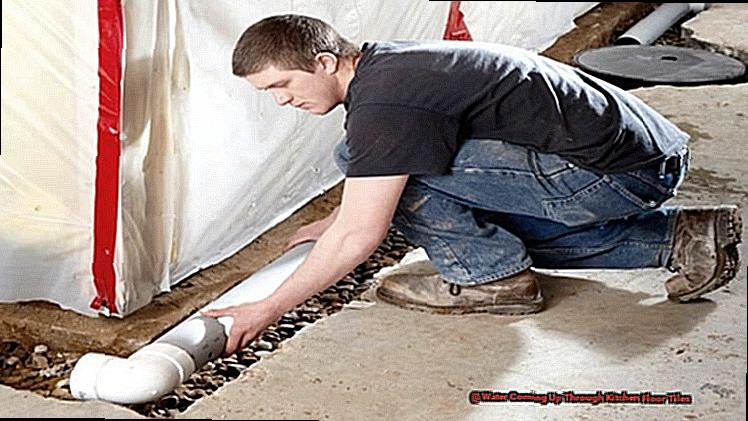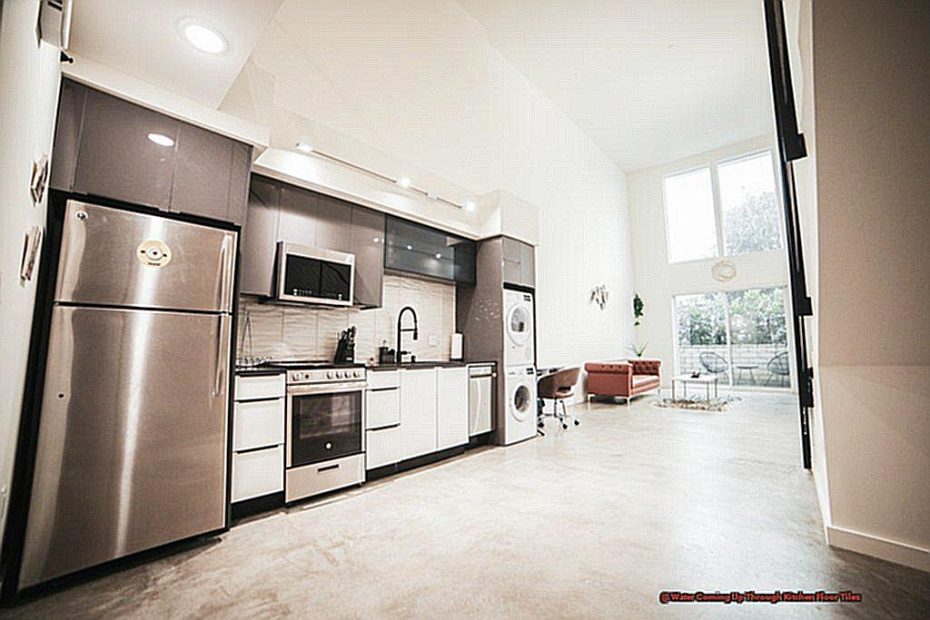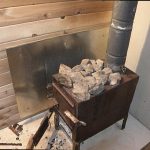Do you feel the dampness under your feet as you walk across your kitchen floor?
Is water seeping through the tiles, leaving puddles and a sinking feeling in your stomach? This is a frustrating and worrisome issue that many homeowners face.
Not only does it create a mess, but it can also lead to expensive repairs and potential damage to your home’s foundation. In this blog post, we will explore the common causes of water coming up through kitchen floor tiles and offer solutions for addressing this problem effectively.
So if you’re tired of constantly mopping up water or concerned about the long-term effects on your home, continue reading to discover more about this all-too-common household dilemma.
Contents
- 1 What Can Be Done To Stop Water From Seeping Through Tile Floors?
- 2 The Most Common Causes Of Water Under Tile Floors
- 3 Determining The Cause Of Water Under Tiles and Fixes
- 4 What Causes Water To Seep On The Ground During Floods?
- 5 The Cause And Solution Of Water Seeping On The Floor Even If It Doesn’t Rain
- 6 The Causes and Fixes of Water Seeping On The Floor After A Rainstorm
- 7 Conclusion
What Can Be Done To Stop Water From Seeping Through Tile Floors?
There are a variety of measures that can be taken to prevent or halt water from seeping through tile floors in the kitchen. These include repairing any damaged areas, addressing leaks and excessive moisture, and implementing preventative measures against future water damage.
Fixing damaged areas:
- If there are cracks or gaps in the grout or tiles, it is crucial to regrout and replace any damaged tiles to avoid water from seeping through.
- Applying a high-quality sealant can also reinforce the waterproofing of the grout joints and tiles.
Addressing leaks and excessive moisture:
- Repairs should be made immediately to any leaks in plumbing pipes or sewer systems to prevent water from seeping under the tiles.
- Regularly checking for and fixing any leaks around pipes, walls, or windows can also help prevent water damage.
- Maintaining a well-ventilated kitchen free of excess moisture can also prevent mold growth and damage to the tiles.
Preventative measures:
- Installing a vapor retarder or waterproofing membrane under the concrete slab can prevent water from migrating through it.
- In areas prone to flooding, installing a drain pipe around the exterior walls can help drain excess water and prevent it from seeping under the tiles.
- Regularly inspecting and maintaining gutters, downspouts, and other external drainage systems can also prevent water from being directed towards the house.

In more severe cases, it may be necessary to seek professional assistance from tilers or contractors who specialize in repairing showers. They can provide long-term solutions such as raising the ground floor or installing new flooring with proper waterproofing measures.
The Most Common Causes Of Water Under Tile Floors
One of the most common reasons for water under tile floors is water leaks from pipes. These leaks can arise from various causes, such as old or faulty pipes, improper installation, or excessive pressure. If you start to notice a sudden increase in your water bill or hear the sound of running water behind your walls, it may be a sign of a pipe leak. To prevent this issue, it is essential to regularly inspect your pipes for any signs of damage and address any leaks immediately.
Another factor that can lead to water under tile floors is a high water table. This occurs when the level of groundwater rises above the foundation of your home, causing water to seep through the ground and into your home. To avoid this issue, ensure that your home has adequate drainage systems in place to divert excess water away from the foundation.
Accidents happen, and spills on your kitchen floor can also result in water seeping under tiles. In more severe cases, floods can occur, causing significant damage to your flooring. To prevent this issue, promptly clean up any spills and address any potential flooding risks in your home.
Over time, the grout or caulk between tiles can deteriorate due to wear and tear or improper installation. This can create gaps where water can seep through and damage the subfloor or ceiling below. To prevent this issue, regularly check and repair any cracks or gaps in the grout or caulk.
In conclusion, identifying the source of water under tile floors is crucial in preventing and resolving this problem. By regularly inspecting for leaks, addressing moisture issues, and maintaining proper drainage, you can ensure that your kitchen tile floors remain dry and in good condition.
Determining The Cause Of Water Under Tiles and Fixes
Water under tiles in kitchen floors can have various causes, ranging from burst pipes and deteriorated grout to improper tiling and inadequate drainage.
To effectively resolve these issues and prevent water from accumulating under tiles, it is crucial to conduct regular inspections for leaks, address any moisture-related concerns, and maintain proper drainage systems.
Furthermore, applying waterproof sealant on the grout and using tile backer boards can act as a barrier against water seeping through the tiles and causing damage.
In situations where water has already accumulated under the tiles, it is imperative to identify the root cause of the problem and properly dry out the area before replacing any damaged tiles or flooring.
The Importance of Regular Inspections
Regular inspections are essential to detect any potential sources of water under tiles. Burst pipes are a common cause, and they can go unnoticed for extended periods if they are located below the surface of the floor.
Additionally, weathered grout or improper tiling can create gaps between tiles, allowing water to seep through. By conducting regular inspections, you can identify these issues early and address them before they lead to significant damage.
Addressing Moisture Issues
Moisture-related concerns can also contribute to water accumulation under tiles. For instance, if there is excess moisture in the air or poor ventilation in the kitchen, it can create a humid environment that promotes water buildup under the tiles.
By addressing these underlying issues, such as fixing leaky faucets or installing proper ventilation systems, you can prevent excess moisture from accumulating and causing damage.
Maintaining Proper Drainage
Proper drainage is crucial to prevent water from accumulating under tiles. If there are any clogs or blockages in the drain system, it can cause water to back up and seep through the tiles.
Regularly inspecting and clearing out drains can help ensure that water flows away from your kitchen floor instead of getting trapped underneath it.
Preventative Measures
In addition to regular inspections and addressing underlying issues, there are also preventative measures that you can take to protect your tiles from water damage. Applying waterproof sealant to the grout and using tile backer boards can act as a barrier against any potential water seepage. These simple steps can go a long way in preventing costly repairs in the future.
Properly Addressing Existing Water Under Tiles
If there is already water under your kitchen tiles, it is crucial to address the root cause of the issue before replacing any damaged tiles or flooring. Otherwise, the issue will continue to persist and cause further damage. By identifying and fixing the underlying problem, such as fixing a burst pipe or improving drainage, you can properly dry out the area and prevent future water buildup.
There are various causes of water under tiles in kitchen floors and taking preventative measures can help prevent costly repairs in the future.
What Causes Water To Seep On The Ground During Floods?
During periods of flooding, water can seep through the kitchen floor tiles as a result of the increased pressure from standing water around the house. This pressure can force water through cracks or gaps in the tile grout, allowing it to penetrate the space underneath the tiles.
In addition, if the home’s foundation is not properly sealed or has cracks, floodwaters can easily seep through and reach the kitchen floor.
This can also occur if the concrete slab lacks a vapor retarder, which acts as a barrier to prevent water from passing through. The combination of high water pressure and inadequate sealing can result in significant water seepage under kitchen floor tiles during floods.
Moreover, frequent flooding can cause damage to the structural integrity of the home, as persistent exposure to water can weaken the foundation and lead to cracks in the walls and floors. These cracks create more openings for water to seep through and cause further harm. It is crucial to address any flooding and water seepage issues promptly to prevent long-term damage to your home.
To prevent water from penetrating kitchen floor tiles during floods, it is imperative to take preventative measures such as installing a vapor retarder before laying down new tiles or sealing any existing cracks or gaps in the grouting. Regular inspections of your home’s foundation and drainage systems can also help identify any potential problems before they escalate.
The Cause And Solution Of Water Seeping On The Floor Even If It Doesn’t Rain
The cause and solution of water seeping on the floor even if it doesn’t rain can be complex. There are various factors that can contribute to this issue, such as a high water table on the property, deteriorating grout or caulk, broken or leaking water pipes, or a faulty drainage system. If left unaddressed, these issues can lead to long-term damage and costly repairs. However, there are some potential solutions that can help prevent this problem from occurring.
One effective solution is installing a vapor retarder. This material acts as a barrier and helps to control moisture, reducing the risk of water damage. It is typically placed under the flooring or between the subfloor and tile to prevent moisture from seeping through and causing damage.
Regular inspections and maintenance are also crucial in preventing water seepage through floor tiles. By regularly checking for any signs of moisture or damage, potential issues can be identified early on and addressed before they become bigger problems. It is important to promptly repair any cracks in the grout or caulk to prevent water from seeping through.
Another key solution is addressing any underlying plumbing or drainage issues. Leaking or broken pipes in the bathroom can create excess moisture that can cause damage over time. Regularly checking for leaks and addressing them immediately is important. Additionally, ensuring proper drainage around your home can prevent water from pooling near the foundation and seeping into the kitchen floor.
In conclusion, there are multiple causes of water seepage through kitchen floor tiles, but taking proactive measures can prevent this issue and avoid potential long-term damage. By installing a vapor retarder, conducting regular inspections and maintenance, and addressing any underlying plumbing or drainage issues, you can protect your home from water damage.
The Causes and Fixes of Water Seeping On The Floor After A Rainstorm
Water seeping on the floor after a rainstorm can stem from a range of problems, including plumbing leaks, excess groundwater, and clogged gutters. These issues can lead to damage and mold growth if not dealt with promptly. Here are some common causes and solutions for water seeping on the floor after a rainstorm:
- Leaks in the plumbing or ceiling: Check for stains or moisture signs on the ceiling above the wet spot on the floor. Use a wet vacuum or mop to absorb the water and hire a plumber to fix the leak.
- Leaks within your home’s plumbing: Check your water meter to see if there is a leak, and call a contractor to locate the source.
- Leaky in-floor heating system: Use infrared thermal cameras or hire a specialist to find and repair the leak, as it can lead to mold and pest infestations.
- Excess groundwater or rising water table: Check and maintain your sump pump, install a drainage system, or waterproof your basement to prevent future leaks.
Improperly sealed windows and doors: Seal with caulk or replace old windows/doors if needed.
- Clogged or broken drain lines: Look for unpleasant odors and slow draining sinks as indicators of this issue, and contact a plumber for professional assistance.
- Clogged gutters or poor drainage: Regularly clean gutters and consider installing drains around your home to redirect water away from the foundation.
To address these issues effectively, it is crucial to tackle the underlying cause. This may involve hiring professionals like plumbers or contractors to fix any leaks, install drainage systems, or waterproof your home. Regular maintenance and inspections can also help prevent future problems.
In addition to addressing the root cause of water seepage, it is important to properly dry out affected areas following a rainstorm. Fans, dehumidifiers, wet vacuums, mops, and sunlight can all be utilized for this purpose. If there is carpet padding, it may need to be replaced to prevent mold growth.
Conclusion
In conclusion, the issue of water coming up through kitchen floor tiles can be a major headache for homeowners.
Not only does it create a messy and unpleasant environment, but it can also lead to costly repairs and potential damage to your home’s foundation. This blog post has delved into the common causes of this problem and provided effective solutions, such as repairing damaged areas, addressing leaks and excessive moisture, and implementing preventative measures.
It is crucial to regularly inspect for leaks and properly maintain drainage systems to prevent water from accumulating under tiles. Additionally, installing a vapor retarder or waterproofing membrane can serve as a barrier against water seepage.
In cases where water has already accumulated under the tiles, it is essential to identify the root cause and thoroughly dry out the area before replacing any damaged tiles or flooring.





